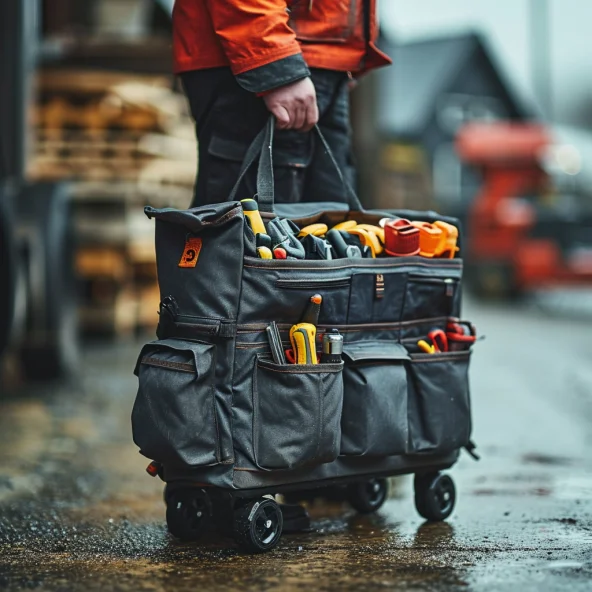Roller tool bags are a specialized type of portable storage designed for the organization, transportation, and protection of tools and equipment. Typically constructed from durable materials, these bags are outfitted with wheels and a telescoping handle, allowing for ease of movement over a variety of terrains. The structure of a roller tool bag may include multiple compartments, pouches, and loops, which enable users to categorize and access tools efficiently.
Ideal for professionals like contractors, electricians, and carpenters, roller tool bags offer the convenience of a traditional toolbox with added mobility. The robust fabric such as polyester or nylon often reinforces stress points, ensuring longevity in demanding work environments. Furthermore, certain models may feature weather-resistant properties, safeguarding the tools within from elements like rain or dust that could compromise their functionality or lead to corrosion.
Innovations in the design of roller tool bags cater to the evolving needs of tradespeople. These innovations include modular systems that allow for customization based on the task at hand, as well as integrated locking systems for security. Acknowledging the physical strain of carrying heavy equipment, roller tool bags are the ergonomic solution that industry professionals require to bring their workshop to the job site without compromising their health or efficiency.
The dynamic landscape of vocational industries has always demanded solutions that blend functionality with convenience. Within this realm, roller tool bags have emerged as the quintessential companion for trade and maintenance professionals who need their tools accessible and organized. The evolution of these mobile workshops parallels the innovative spirit that fuels the progression of trade skills and duties.
This article delves into the transformative impact that roller tool bags have on the way work is conducted on-site. No longer a luxury, these devices have become essential in enhancing productivity and mitigating the physical strain associated with manual labor. As the industry acknowledges the value of worker well-being, roller tool bags stand as a testament to how equipment can adapt to human needs.
Moving beyond mere storage, modern roller tool bags are a symphony of design and utility. They are improving work practices by providing an intelligent and adaptable system for tool management. In this expansive review, we will explore the sophisticated features of today’s roller tool bags, their significance in the current work environment, and the way they propel the capabilities of professionals across various trades.
Rolling into Efficiency: How Roller Tool Bags Are Revolutionizing On-Site Work
The construction industry is witnessing a significant shift with the introduction of roller tool bags. These innovative carriers are designed to alleviate the physical burden on workers. Not only do they streamline the process of transporting heavy tools, but they also offer easy access and organization, transforming the way tradespeople operate on-site. Craftsmen can now roll their entire toolkit to the precise location where it’s needed, demonstrating the essence of functional mobility while at work.
As professionals move across varied terrain, traditional toolboxes can become cumbersome. Roller tool bags, however, come with robust wheels and a telescoping handle, making navigation through construction sites feel almost effortless. Increased efficiency isn’t just noticed by workers; project managers observe significant time savings during the workday as tools are moved quickly and safely. The reduction in time spent hauling equipment allows for more focus on the task at hand.
Safety on the job site is paramount, and roller tool bags are contributing to this priority. By reducing the need to lift heavy boxes, they minimize the risk of back strain and related injuries. Workers appreciate the ergonomic design of these bags, which often include padded handles and a balanced distribution of weight. A safer work environment also leads to decreased downtime, an aspect highly valued in meeting tight deadlines.
Selecting the perfect roller tool bag presents a new challenge. Considering durability, size, and compartmentalization is crucial for meeting specific needs. From electricians to carpenters, each trade requires different configurations for their tools, and the availability of customizable options in roller bags is appealing to these diverse users. Ensuing paragraphs will delve more into the aspects of choosing the right roller tool bag.
In conclusion, roller tool bags are transforming on-site workflows by providing a blend of practicality and comfort. Their design encourages a more efficient and less physically taxing work experience. As the construction industry continues to innovate, the sight of workers rolling their tools beside them is becoming a hallmark of modern craftsmanship. The roll-forward mentality exemplified by these tool carriers underscores a movement toward smarter, safer, and swifter work practices on the job site.
From Toolbox to Roller Bag: Evolution of Portable Tool Storage
Through the years, the evolution of portable tool storage has closely mirrored the progress within various crafts and trades. Beginning with basic wooden boxes and advancing today toward highly sophisticated roller tool bags, the transformation has been driven by a demand for greater efficiency and ergonomics. Tool storage systems have had to adapt, embracing changes in technology and innovations in materials to provide professionals with the convenience and durability they require.
The toolbox, once a symbol of the trade, has seen its dominance challenged by the roller tool bag. With the modern work environment becoming increasingly mobile, the limitations of traditional toolboxes grew evident. Heavy lifting and the tedious act of carrying these containers have led to the quest for a more resourceful solution. Roller tool bags have answered this call, offering unparalleled portability and ushering in an era where transporting one’s tools no longer involves back-breaking effort.
Paying homage to the past, some aspects of the toolbox design have persisted within the roller tool bag. Robust construction and secure latches continue to be integral, ensuring that tools are protected and accessible. However, the advancement in materials has led to bags that are lighter, more weather-resistant, and adaptable to various working conditions. The inclusion of extendable handles and sturdy wheels crucially adds to their functionality.
The shift from toolbox to roller bag has also been propelled by a growing recognition of professional health and safety. With a focus on preventing workplace injuries, the design of tool storage options now places a strong emphasis on ergonomics. Roller bags are at the forefront of this, offering designs that decrease the chance of muscle strains and improve overall well-being for tradespeople.
Reflecting on the development from traditional toolboxes to modern roller bags marks a turning point in how professionals manage and transport their equipment. Rugged yet refined, flexible but secure, roller tool bags symbolize a commitment to advancing trade practices while prioritizing the health of workers. As tool storage continues to evolve, it is clear that the drive for innovation is powered by a desire to better support the individuals in the field.
Pack, Roll, and Go: The Ultimate Guide to Choosing the Right Roller Tool Bag
Choosing the right roller tool bag is critical for any professional seeking convenience and efficiency on the job. To aim high, being aware of one’s needs is key to making an informed decision. This guide delves into the features and considerations necessary when selecting a bag. The balance between size, weight capacity, and versatility determines the overall effectiveness of the tool carrier in daily operations.
Consider first the size and layout of the roller bag. The appropriate dimensions should accommodate the user’s toolset without being excessively bulky. A bag too large can be cumbersome to navigate, while a bag too small can render ineffective. An organized interior, with customizable compartments and pockets for specific tools, provides easy access and prevents equipment damage that too often occurs in cluttered containers.
Material strength and durability are also essential for a roller tool bag built to last. High-density fabrics like ballistic nylon resist wear and tear, while reinforced seams and corners shield against the rigors of constant movement. Reflecting on the different tasks and environments, the material choice can be a decisive factor for the longevity of the bag. Opting for water-resistant or waterproof options ensures tools are safeguarded against inclement weather.
When assessing wheels and handles, standards should be uncompromising. Heavy-duty, all-terrain wheels are a boon for any worksite, providing mobility across uneven ground. A sturdy telescoping handle should grant control and not wobble, while also collapsing fully to save space during storage or transport. The functionality of these components directly impacts the practicality of a roller tool bag, hence their importance cannot be overstated.
The addition of safety and security features completes the picture of a well-rounded roller tool bag. Integrated locks and durable zippers protect the valuable contents, while reflective strips enhance visibility for those who work into the night. A tool bag that doesn’t compromise on safety ensures that both the carrier and the tools contained within stay secure in various work environments.
Ultimately, selecting a suitable roller tool bag is about matching the carrier’s capabilities with the demands of one’s craft. Considering size, material strength, durability, and added features, a well-chosen bag can significantly ease the daily grind. The right roller tool bag becomes an indispensable companion for any on-the-go professional, ensuring that they are always prepared, no matter where their work may take them.
Conquer the Job Site: Maximizing Productivity with Roller Tool Bags
Increased productivity on the job site is the aim, and roller tool bags are the means to achieve it. With their integration into work routines, tradespeople are experiencing noticeable improvements in efficiency. Gone are the days of multiple trips to fetch tools. Now, a well-organized roller bag allows for carrying an extensive set of tools in one efficient journey. This translates directly into more time on task and less time spent on preparation and cleanup.
The layout of a tool bag can make or break its functionality. Roller tool bags with intuitive design allow for quicker tool retrieval, which means less time searching and more time working. Multiple compartments and dividers keep tools in place and ready for action.
Moreover, a roller tool bag can become a mobile workstation. Some models have features like fold-out trays or detachable pouches that extend the workspace. A professional can roll up to a project, unpack what’s necessary, and begin work almost immediately.
Furthermore, maintaining equipment is essential in extending its lifespan and ensuring reliability. In conclusion, roller tool bags are a strategic investment for professionals keen on maximizing their productivity.
The Mobile Mechanic’s Best Friend: An In-Depth Look at Roller Tool Bags
For mobile mechanics, roller tool bags stand as an invaluable ally in the battle against time and physical strain. Their rise in popularity is testament to their effectiveness in making transport of heavy sets of tools manageable. Most importantly, it ensures all tools are at arm’s reach, a necessity for swift and successful work.
The design of roller tool bags considers the unique challenges faced by mobile mechanics. Heavy-duty fabrics and water-resistant coatings keep tools dry, while sturdy zippers and locks withstand the daily wear and tear. Strength and resilience are hallmarks of a roller tool bag ready for the road.
Configurability is also crucial for mobile mechanics who need to adjust their kit depending on the job. Wheel quality is another integral consideration of the roller tool bag. Mechanics require wheels that can handle the weight of tools and smoothly transition from asphalt to gravel or over thresholds. In closing, the roller tool bag stands as an indispensable piece of equipment for the mobile mechanic. Merging versatility with durability, these bags support the complex demands of a mechanic’s mobile work environment.



